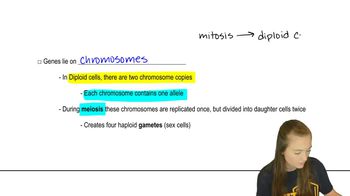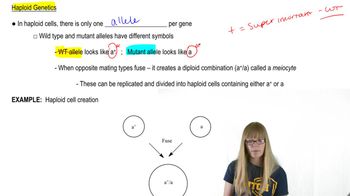Table of contents
- 1. Introduction to Genetics51m
- 2. Mendel's Laws of Inheritance3h 37m
- 3. Extensions to Mendelian Inheritance2h 41m
- 4. Genetic Mapping and Linkage2h 28m
- 5. Genetics of Bacteria and Viruses1h 21m
- 6. Chromosomal Variation1h 48m
- 7. DNA and Chromosome Structure56m
- 8. DNA Replication1h 10m
- 9. Mitosis and Meiosis1h 34m
- 10. Transcription1h 0m
- 11. Translation58m
- 12. Gene Regulation in Prokaryotes1h 19m
- 13. Gene Regulation in Eukaryotes44m
- 14. Genetic Control of Development44m
- 15. Genomes and Genomics1h 50m
- 16. Transposable Elements47m
- 17. Mutation, Repair, and Recombination1h 6m
- 18. Molecular Genetic Tools19m
- 19. Cancer Genetics29m
- 20. Quantitative Genetics1h 26m
- 21. Population Genetics50m
- 22. Evolutionary Genetics29m
2. Mendel's Laws of Inheritance
Inheritance in Diploids and Haploids
Problem 24
Textbook Question
Textbook QuestionIn the wasp Bracon hebetor, a form of parthenogenesis (the development of unfertilized eggs into progeny) resulting in haploid organisms is not uncommon. All haploids are males. When offspring arise from fertilization, females almost invariably result. P. W. Whiting has shown that an X-linked gene with nine multiple alleles (Xₐ, Xb, etc.) controls sex determination. Any homozygous or hemizygous condition results in males, and any heterozygous condition results in females. If an Xₐ/Xb female mates with an Xₐ male and lays 50 percent fertilized and 50 percent unfertilized eggs, what proportion of male and female offspring will result?
 Verified Solution
Verified SolutionThis video solution was recommended by our tutors as helpful for the problem above
Video duration:
4mPlay a video:
284
views
Was this helpful?
Related Videos
Related Practice
Showing 1 of 2 videos


